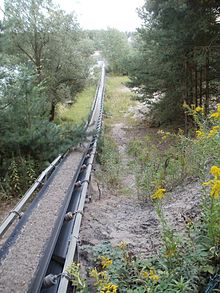Conveyor belt

The conveyor belt is the most important construction element of the belt conveyor . It consists of an endless belt that revolves on support rollers or slideways, which simultaneously serves as a support and traction means ("continuous conveyor with traction means").
Structure and function of the conveyor belts
Each conveyor belt has a traction-transmitting carcass made of textile or steel cable inserts. These carcasses are surrounded on all sides by wear-resistant rubber cover plates and the rubber edge protection. In general, a conveyor belt consists of the following components:
- Inserts such as textile or steel cable inserts that transmit tensile forces
- additional puncture protection devices (if required).
A distinction must be made between conveyor belt and conveyor belt. Conveyor belts are used for bulk goods (coal, ores, sand, cement, etc.), while conveyor belts are used for general cargo (packages, etc.). Conveyor belts are generally longer, wider, thicker and stronger than conveyor belts.
Lower cover plate (running side)
The running side represents the lower cover plate of the conveyor belt. The thickness of the running side is chosen to be somewhat weaker than the carrying side . However, it still has to guarantee a sufficient cushioning effect.
Upper cover plate (carrying side)
The carrying side represents the upper cover plate of a conveyor belt. It is exposed to particular wear when it comes into contact with the transported goods . It must therefore be chosen thicker than the running side . The thickness of the supporting side is determined by:
- the attack severity of the conveyed goods to be transported
- the kinetic energy when feeding the conveyed material
- the frequency of the conveyed goods task.
Rubber edge protection
A conveyor belt usually has rubber edge protection as part of its rubber coating . This rubber sleeve protects the tension member against mechanical wear and tear and chemical effects of the conveyed goods as well as against moisture and bacteriological influences.
Tension member
Tension members are an important part of a conveyor belt. They are used to transfer the tensile forces generated in the conveyor belt and give the conveyor belt the necessary load-bearing capacity and impact resistance.
Two basic types are known for tension members:
- Steel cable inserts and
- Textile insoles.
Steel cable inserts have a higher tensile strength / breaking strength than textile inserts. There are steel cord conveyor belts and textile conveyor belts.
Steel cord conveyor belt
The transmission of very high tensile forces, which enable long conveying distances and high lifting heights, characterize the steel cord conveyor belt. It consists of steel cables embedded in rubber.
Textile conveyor belt
The textile conveyor belt consists of tension-bearing fabric inserts that are surrounded on all sides by the rubber cover plates and, optionally, the rubber edge protection . This rubber sleeve protects the tension member against mechanical wear and tear and chemical effects of the conveyed goods as well as against moisture and bacteriological influences. A textile conveyor belt consists of one or more layers of fabric. The conveyor belt is still available in various specifications, including a sliding belt in which the running side does not consist of a rubber layer, but of a non-load-bearing fabric, the so-called sliding layer.
Belt test
There are facilities that test and certify conveyor belts for strength. In Germany, for example, this is the Institute for Transport and Automation Technology . Belts are tested here according to DIN 22110-3. A defined number of load changes on the belt is simulated and the durability is assessed. In addition to testing the conveyor belts themselves, testing the support rollers in accordance with DIN 22112-3 is important.
literature
- Reinald Skiba : Taschenbuch Betriebliche Sicherheitstechnik. 3rd edition, Erich Schmidt Verlag, Regensburg and Münster 1991, ISBN 3-503-02943-5
- Walter Bischoff , Heinz Bramann, Westfälische Berggewerkschaftskasse Bochum: The small mining dictionary. 7th edition, Verlag Glückauf GmbH, Essen 1988, ISBN 3-7739-0501-7
Individual evidence
- ^ Heinrich Dubbel; Karl-Heinrich Grote, Jörg Feldhusen (Ed.): Paperback for mechanical engineering , Springer, Berlin / Heidelberg / New York 2007, ISBN 978-3-540-49714-1

